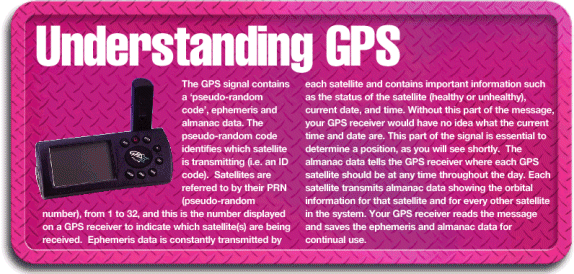| |
| Global
Positioning Systems ...continued |
| |
|
accuracy improves dramatically. Satellite geometry also becomes an
issue when using a GPS receiver in a vehicle, near tall buildings,
or in mountainous or canyon areas. When the GPS signals are
blocked from several satellites, the relative position of the
remaining satellites will determine how accurate the GPS position
will be (and the number of remaining satellites will determine if
a position can even be determined). As more and more of the sky is
obstructed by buildings or terrain, it becomes increasingly
difficult to determine a position. A quality GPS receiver
indicates not only which satellites are available for use, but
where they are in the sky (azimuth and elevation) so you may
determine if the signal of a given satellite is being obstructed. |
|
|
A number of issues come into play here:
1. What is the intended application? The
most important issue is finding a GPS suitable for your
application. You can quickly narrow your choices down by
identifying which models are available for your application. For
example, do you need GPS mapping or just co-ordinate information?
2. In some cases, you may still have a lot
of options from which to choose. For example, if your intended use
is hiking or fishing, a GPS for outdoor recreation is suitable,
but so is a handheld GPS designed for boating or flying. In this
case, you may have to examine specific features more closely. |
|
 |
|
Another source of error is multipath. Simply put, multipath is the
result of a radio signal being reflected off an object. Multipath
is what causes ‘ghost’ images on a television set. With GPS,
multipath occurs when the signal bounces off a building or terrain
before reaching the GPS receiver’s antenna, meaning that the
signal takes longer to reach the receiver. This added time makes
the GPS receiver think the satellite is farther away than it
really is, which adds error to the overall position determination.
When they occur, multipath errors typically add well under 3
metres of error to your overall position.
Yet another source of error is propagation delay due to
atmospheric effects and internal clock errors. In both cases, the
GPS receiver is designed to compensate for these effects and will
do so quite efficiently, but very small errors can still occur.

A typical civilian GPS receiver now provides 1m to 10m accuracy,
depending on the number of satellites available and the geometry
of them. More sophisticated and expensive GPS receivers can
provide accuracies within a centimetre by using more than one GPS
frequency. |
|
|
3. What is the price range? Once you’ve narrowed the field, you’ll
most likely still have several models over a range of prices from
which to choose. Examine each model closely to determine what the
higher-priced models have that the lower-priced models don’t, and
whether the lower-priced model is sufficient to do the job.
4. Which model do you like the best? Choosing the right GPS
receiver for you is two parts rational planning and one part
simple preference. If rational planning still leaves you with two
or three models to choose from, try operating each one. Sometimes
the differences in operation are dramatic.
You may find one very easy to use and understand, while another
seems much more complicated and difficult. Choose the GPS receiver
that you LIKE best! Then you are more likely to still be happy
with the decision you made in years to come.

A number of issues come into play here:
1. What is the intended application? The most important issue is
finding a GPS suitable for your application. You can quickly
narrow your choices down by identifying which models are available
for your application. |
|
| |
Previous
Page |
|
![]()